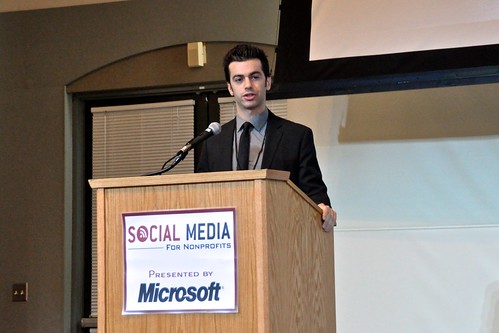Yesterday was the fourth Social Media for Nonprofits conference, and the first one in Los Angeles. A packed room of nonprofits and individual activists gathered to learn best practices. The following blog is a summary of the first half sessions. A second blog post focusing on the final four sessions will be posted later today.
JD Lasica, founder, Socialbrite
JD Lasica provided three insights in his presentation (available online): 1) Preparing to tell stories; 2) telling the stories, and then 3) using your community to tell stories. Storytelling is part of the human psyche, and helps us get through the thousands of messages we receive everyday. The Internet and social media has helped us restore storytelling to the modern vernacular. As a result, everyone is a media company, including nonprofits.
Here are three steps your nonprofit can take to get ready:
Preparation: First, figure out your story. Then understand who your storytellers are internally.
Storytelling: Figure out how you want to tell stories. Personal stories are a big hit in social media. Worry less about viral videos, and focus on creating video and stories that resonate with the right 500 people.
Community: Activists make up 7% of a database, but they take 31% of your actions. Understand who your champions are. Let them spread your message.
Keynote: Evan Bailyn, Author and Social Entrepreneur
Evan Bailyn, a social entrepreneur, provided a moving story about how he went from capitalist to social good ventures and starting his eponymous foundation. He then discussed how to get new donors through four primary means: 1) attend parties, 2) host an event, 3) great press, or 4) introductions from influential contacts.
A successful brand advocate needs both influence AND energy for your cause–these are equally valuable assets, said Evan. If you can both, you have an ideal advocate.
The media is a critical component to success for an organization. Hire a publicist. But if you can’t do that, get to know who the reporters are. Manage a list of 20-30 of them, and send them personalized emails. Give aways things for free; it is a good faith thing, and it helps you more than any other effort. Shine and speak from your heart. It shows your intentions.
Increasing your awareness of your organization. Attract an audience organically through content. A viral video can be created. Follower count numbers do matter with corporations and potential sponsors and search.
Evan provided five keys to beating out the Google search engine: 1) an older site, 2) proper meta page titles, carefully selected keywords, 4) authoritative links and 5) great content.
Holly Ross, Executive Director, NTEN
Holly Ross from NTEN offered tips on how to create social media programs that only require 30 minutes a day. You have to focus on what matters, and architect what you are going to do. She discussed building outcomes and what you want to do, such as creating conversations and actions, nurture supporters, and more.
Integrated strategy, SMART goals, content creation, listening, commenting, measurement and intelligent use of the right social networks were all stressed by Holly. Her effort today was an ongoing drum beat she has engaged in ever since the NTEN We Are Media project with Beth Kanter.
Bryan Breckenridge, Head of Nonprofit Solutions, LinkedIn
Bryan removes the cost barrier for pro services on LinkedIn, and trains people on best practices. Concentrate your energy on LinkedIn, he said, and you can build a strong effort. It’s about focusing, he said, and then led the room in a song exercise to focus their attention. 120 million people and 75% of the Fortune 500 are on LinkedIn. Driving positive social change is the number one reason why LinkedIn Nonprofit Solutions exists.
InMaps allows you to map your LinkedIn profile. http://learn.linkedin.com/nonprofits is the place to learn how to build out your profile and your organization’s pages. There are six tips for both individuals and organizations on the learning page.
Charles Porch, Consumer Marketing, Facebook
Charles Porch on the Facebook mission: “Give people the power to share and make the world more open and connected.” Currently there are 750 million Facebook users, half of which come back and use it every day. In the United States, there are 50 million active users.
Facebook’s Nonprofit product vision is three-pronged: 1) everyone on Facebook is asked to use their authentic identity, 2) connections with other people are critical too, and 3) tools allow people to interact. Impact from Facebook’s standpoint is making great tools that are easy to use, and educate people on how to use them.
Making your page successful requires you to create a voice, and show real people work there. Program your page with great content. Find something that works for you, think of it like your own magazine. Recognize the people that are on your Facebook page as your fans. Use Insights to drive your programming and interactions.
Charles talked about the push and pull. The average Facebook person has 150 friends. You don’t just want to push out content, you want to pull them in, ask questions, and interact with them. Respond. Engage other organizations, groups and influencers on Facebook, and abroad. Asking for help with folks that have social capital is critical.
Part II of the Social Media for Nonprofits Conference blog can be accessed here.


